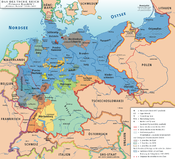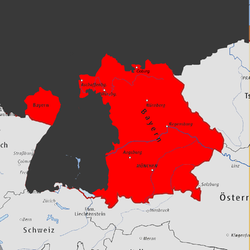- Bavarian Soviet Republic
-
Bavarian Soviet Republic
Bayerische Räterepublik← 
←
1919  →
→
 →
→Flag
Capital Munich Government Socialist republic President - April 6 – April 12 Ernst Toller - April 12 – May 3 Eugen Leviné History - Established April 6, 1919 - Disestablished May 3, 1919 The Bavarian Soviet Republic, also known as the Munich Soviet Republic (German: Bayerische Räterepublik or Münchner Räterepublik) was, as part of the German Revolution of 1918–1919, the short-lived attempt to establish a socialist state in form of a council republic in the Free State of Bavaria. It sought independence from the also recently proclaimed Weimar Republic. Its capital was Munich.
Contents
Kurt Eisner
On 7 November 1918, the first anniversary of the Russian October Revolution, Kurt Eisner of the Independent Social Democratic Party of Germany (USPD) declared Bavaria a "free state" – a declaration which overthrew the monarchy of the Wittelsbach dynasty which had ruled for over 700 years. Eisner became Minister-President of Bavaria. Though he advocated a "socialist republic", he distanced himself from the Russian Bolsheviks, declaring that his government would protect property rights. For a few days, the Munich economist Lujo Brentano served as People's Commissar for Trade (Volkskommissar für Handel).
After Eisner's USPD had lost the elections, he decided to resign from his office. On 21 February 1919, as he was on his way to parliament to announce his resignation, he was shot by the right-wing nationalist Anton Graf von Arco auf Valley, who was rejected from membership in the Thule Society because of Jewish ancestry on his mother's side. This assassination caused unrest and lawlessness in Bavaria, and the news of a soviet revolution in Hungary encouraged communists and anarchists to seize power.
Politics of the Soviet Republic
On 6 April 1919, a Soviet Republic was formally proclaimed. Initially, it was ruled by USPD members such as Ernst Toller, and anarchists like Gustav Landauer, Silvio Gesell and Erich Mühsam. However, Toller, a playwright, was not very good at dealing with politics, and his government did little to restore order in Munich.[citation needed]
His government members were also not always well-chosen. For instance, the Foreign Affairs Deputy Dr. Franz Lipp (who had been admitted several times to psychiatric hospitals), declared war on Switzerland over the Swiss refusal to lend 60 locomotives to the Soviet Republic.[1] He also claimed to be well acquainted with Pope Benedict XV[2] and informed Vladimir Lenin via cable that the ousted former Minister-President Hoffmann had fled to Bamberg and taken the key to the ministry toilet with him.[3] As such, the regime collapsed within six days, being replaced by the Communist Party, with Eugen Leviné as their leader.
Leviné began to enact communist reforms, which included expropriating luxurious apartments and giving them to the homeless and placing factories under the ownership and control of their workers. Leviné also had plans to abolish paper money and reform the education system, but never had time to implement them.
Leviné refused to collaborate with the regular army of the city, and also organized his own army, the Red Army (Rote Armee) under Rudolf Egelhofer, similar to the Red Army of Soviet Russia. In order to support the revolutionary government, thousands of unemployed workers volunteered; soon the ranks of the Rote Armee reached 20,000. In response to the massacre of 23 red prisoners by the “regular” army, Red Guards began arresting suspected counterrevolutionaries and on 29 April 1919, eight men, including the well-connected Prince Gustav of Thurn and Taxis, were accused as right-wing spies and executed. The Thule Society's secretary, Countess Hella von Westarp, was also murdered.[4]
Demise
Soon after, on 3 May 1919, what remained loyal of the German army (called the "White Guards of Capitalism" by the communists), with a force of 9,000, and Freikorps such as the Freikorps Epp and the Marinebrigade Ehrhardt, with 30,000, entered Munich and defeated the communists after bitter street fights in which over 1,000 volunteer supporters of the government were killed. About 700 men and women were arrested and executed by the victorious Freikorps. Leviné was condemned to death for treason.
See also
References
- ^ p.365 Taylor, Edumund The Fall of the Dynasties: The Collapse of Old Order 1963 Weidenfeld & Nicolson
- ^ Gustake Noske, Von Kiel bis Kapp, p. 136
- ^ Paul Werner (Paul Frölich), Die Bayerische Räterepublik. Tatsachen und Kritik, p. 144
- ^ Timebase Multimedia Chronography. Timebase 1919. Accessed September 23, 2006.
External links
- Lenin: Message of Greetings to the Bavarian Soviet Republic
- fractal-vortex: Bavarian Soviet Republic
- Towards the brink: Munich 1918–1919
 States of Germany during the Weimar Republic (1919–33)
States of Germany during the Weimar Republic (1919–33)States Anhalt · Baden · Bavaria · Brunswick · Hesse · Lippe · Mecklenburg-Schwerin · Mecklenburg-Strelitz · Oldenburg · Prussia · Saxony · Schaumburg-Lippe · Thuringia (from 1920) · Waldeck (until 1929) · Württemberg

City-states Until 1920 Elder · JuniorUnofficial Categories:- Former countries in Europe
- States and territories established in 1919
- States and territories disestablished in 1919
- 1919 disestablishments
- Bavarian Soviet Republic
- Communism in Germany
- Communist revolutions
- Early Soviet republics
- History of anarchism
- History of Bavaria
- History of Munich
- Short-lived states of World War I
- Socialism
- Weimar Republic
- German Revolution of 1918–19
Wikimedia Foundation. 2010.


